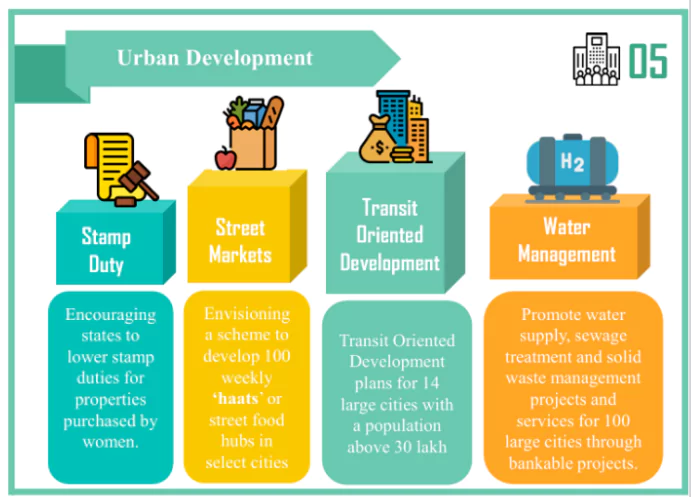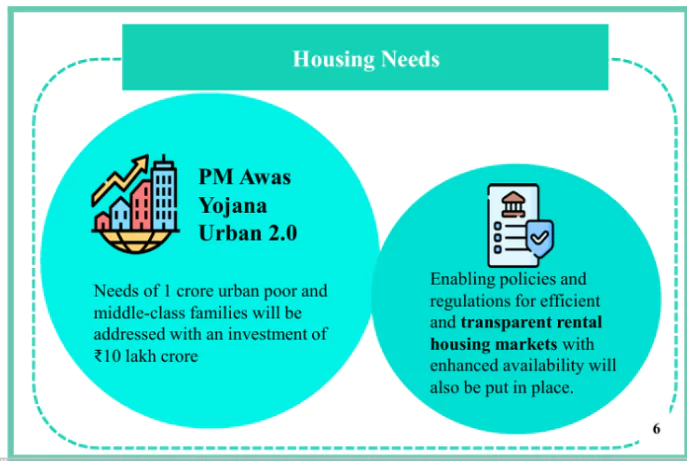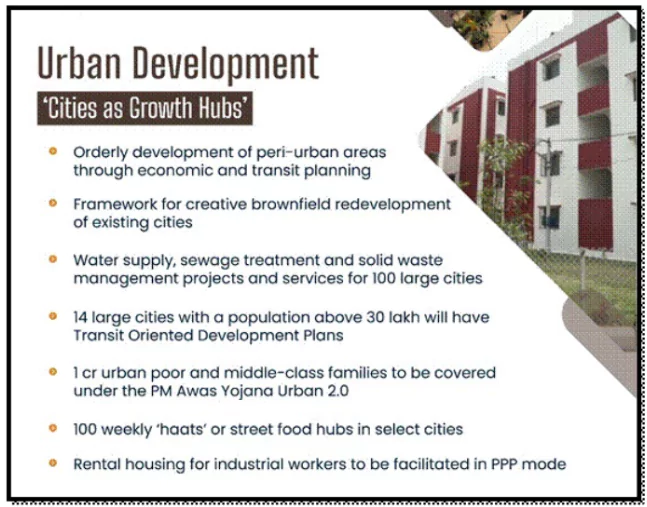One of the key focal points of the Union Budget 2024-25 is urban development, which is addressed through various initiatives aimed at improving housing, rental facilities, city planning, water supply, sanitation, and support for street vendors.
- The Union Budget 2024-25 emphasises the government’s commitment to steering the country towards robust development and widespread prosperity.
About Urban Transformation Strategies in the Union Budget 2024-25

The Union Budget 2024-25’s focus on urban development underscores the government’s commitment to providing housing, rental facilities, and essential services to urban and rural populations. Through substantial investments and strategic initiatives, the budget aims to foster economic growth, improve living standards, and promote sustainable urbanisation across the country.
- Urban Housing: The Union Budget 2024-25 has announced the allocation for the construction of three crore additional houses under the PM Awas Yojana (PMAY), covering both rural and urban areas.
- Under the PM Awas Yojana Urban 2.0, housing needs of 1 crore urban poor and middle-class families will be addressed with an investment of ₹ 10 lakh crore.
- Implementation Strategy: This will include:
 Central Assistance: ₹ 2.2 lakh crore in the next 5 years
Central Assistance: ₹ 2.2 lakh crore in the next 5 years- Interest Subsidy: To facilitate loans at affordable rates
- Enabling Policies and Regulations: For efficient and transparent rental housing markets with enhanced availability
- PM Awas Yojana (PMAY): Since its inception in 2015 for urban areas and 2016 for rural areas, the PMAY has focused on providing pucca houses with essential amenities such as household toilets, LPG connections, electricity, and functional household tap connections.
- The scheme also mandates that the female head of the family be the owner or co-owner of the house, promoting women’s empowerment among economically weaker sections (EWS) and low-income groups (LIG).
Enroll now for UPSC Online Course
- Rental Housing: The budget highlights the facilitation of rental housing with dormitory-type accommodation for industrial workers through PPP mode, supported by Viability Gap Funding (VGF) and commitment from anchor industries.
 Cities as Growth Hubs: In collaboration with states, the Union Government will facilitate development of ‘Cities as Growth Hubs’.
Cities as Growth Hubs: In collaboration with states, the Union Government will facilitate development of ‘Cities as Growth Hubs’.
- Achievement Strategy: The development of ‘Cities as Growth Hubs’ will be achieved through economic and transit planning, and orderly development of peri-urban areas utilising town planning schemes.
- Creative Redevelopment of Cities: For creative brownfield redevelopment of existing cities with a transformative impact, the government will formulate a framework for enabling policies, market-based mechanisms and regulation.
- Transit Oriented Development: This Development plans for 14 large cities with a population above 30 lakh will be formulated, along with an implementation and financing strategy.
- Water Supply and Sanitation: The Union Government will promote water supply, sewage treatment and solid waste management projects and services for 100 large cities through bankable projects.
-
- These projects will also envisage use of treated water for irrigation and filling up of tanks in nearby areas.
- Implementation: By the Union Government in partnership with the State Governments and Multilateral Development Banks.
- Weekly ‘Haats’: Building on the success of PM SVANidhi Scheme in transforming the lives of street vendors, the Government envisions a scheme to support each year, over the next five years, the development of 100 weekly ‘haats’ or street food hubs in select cities.
- Stamp Duty: Those states will be encouraged by the Union Government which continue to charge high stamp duty to moderate the rates for all, and also consider further lowering duties for properties purchased by women.
- This reform will be made an essential component of urban development schemes.
- Pradhan Mantri Gram Sadak Yojana (PMGSY): Phase IV of PMGSY will be launched to provide all-weather connectivity to 25,000 rural habitations which have become eligible in view of their population increase.
- Atal Mission for Rejuvenation and Urban Transformation (AMRUT): The Union Finance Minister has announced the availability of the VGF window, provided that the project is taken up as a commercial venture in PPP Mode.
- It provides ₹8,000 crore for essential infrastructure such as water supply, sanitation, roads, and sewerage systems.
- Huge Investment: The Budget mentions a huge investment of ₹11.11 lakh crore for capex in infrastructure, which includes highways and urban infrastructure. It also offers states an interest-free loan of ₹1.50 lakh crore for infrastructure development.
- Municipalities would get the normal ‘Finance Commission Grant’ of ₹25,653 crore. In addition, a provision of ₹500 crore has been made for the incubation of new cities.
- National Urban Digital Mission (NUDM): It is a new window that has been opened in this Budget, with a provision of ₹1,150 crore, with a focus on the digitisation of property and tax records and their management, with GIS mapping. These will help urban local bodies in managing their finances better, and also help property owners.
- Infrastructure Investment by Central Government: The Budget has provided ₹ 11,11,111 crore for capital expenditure to maintain strong fiscal support for infrastructure over the next 5 years, in conjunction with imperatives of other priorities and fiscal consolidation.
- This would be 3.4% of India’s GDP.
- Infrastructure Investment by State Governments: A provision of ₹ 1.5 lakh crore for long-term interest free loans has been made this year also to support the states in their resource allocation.
- The Union Government will encourage states to provide support of similar scale for infrastructure, subject to their development priorities.
- Private Investment in Infrastructure: Investment in infrastructure by the private sector will be promoted through viability gap funding and enabling policies and regulations.
- A market based financing framework will be brought out.
- Others: Renewable energy projects are being taken up under several schemes by the Government at the city level. In continuation of these efforts, the budget could be financing cities for developing sustainable and climate resilient infrastructure like electric vehicles for public bus transport, developing non-motorized transport infrastructure, increased green cover, developing urban forests, energy and water conservation among others.
Background for Urban Planning and Development in India
Urban planning and development in India have witnessed huge transition from master plan preparation since 1957 to implementation of large scale urban transformation programs like:
- Jawaharlal Nehru National Urban Renewal (JNNURM)
- Smart Cities Mission (SCM)
- Atal Mission for Rejuvenation and Urban Transformation (AMRUT)
- Swachh Bharat Mission-Urban (SBM-U)
- Deendayal Antyodaya Yojana-National Urban Livelihoods Mission
- Pradhan Mantri Awas Yojana-Urban, etc.
- Establishment of Urban Local Bodies: The 74th Constitutional Amendment Act 1992 inserted a new Part IX-A into the Constitution and provided for the establishment of urban local bodies (ULBs), including municipal corporations, as institutions of local self-government.
Check Out UPSC NCERT Textbooks From PW Store
Need for Urban Planning and Development in India
Globally, over 50% of the population lives in urban areas today. By 2045, the world’s urban population will increase by 1.5 times to 6 billion. City leaders must move quickly to plan for growth and provide the basic services, infrastructure, and affordable housing their expanding populations need.
- High Population Dependency: According to UN World Urbanization Prospects 2018, 50% of India’s population will reside in urban areas in 2050 compared to 31% in 2011.
- Cities are home to about 50 crore people, accounting for about 36% of India’s population. The urban population has been growing at a steady pace of 2% to 2.5% annually. The ever-growing pace of urbanisation in India calls for sustained investments, with a vision and determination.
- Economic Contribution: India’s cities occupy just 3% of the nation’s land but contribute approximately 60% of the GDP (United Nations’ 2018 Revision of World Urbanization Prospects and “Cities as Engines of Growth” by Niti Aayog and Asian Development Bank).
- Indian cities will continue playing an important role for economic activities and will be instrumental in achieving the country’s goal of becoming a $ 5 trillion economy.
- Tackling Climate Change: Cities play an increasingly important role in tackling climate change, because their exposure to climate and disaster risk increases as they grow.
- Globally, 1.81 billion people live in high-risk flood zones. Exposure is especially high (about 89%) in the densely populated and rapidly urbanising river plains and coastlines in developing countries.
- To Combat Epidemics: The COVID-19 pandemic was a massive challenge for cities and their citizens, rich and poor alike. Its impact and the measures taken to control the spread of the virus had disproportionate impacts on the poor, marginalised and vulnerable, revealing fault lines in cities’ economic structure, preparedness for such a crisis.
- For Environmental Sustainability: Urban planning ensures that cities are designed in a way to minimise their impact on the environment through measures such as green spaces, energy-efficient buildings, and sustainable transportation options.
- Indian cities are playing an important role to help achieve the nation’s commitment to become net zero by 2070 (Glasgow, COP26) and the commitments made under SDGs.
- The National Mission for Sustainable Habitat (NMSH) under the National Action Plan on Climate Change (NAPCC), aims to make Indian Cities sustainable through improvements in energy efficiency in buildings, management of solid waste and shift to public transport.
Challenges with Urban Planning and Development in India
The speed and scale of urbanisation brings challenges, such as meeting accelerated demand for affordable housing, viable infrastructure including transport systems, basic services, and jobs, particularly for the nearly 1 billion urban poor who live in informal settlements to be near opportunities. Rising conflicts contribute to pressure on cities as more than 50% of forcibly displaced people live in urban areas.
- High Pressure on Resources: The expansion of urban land consumption outpaces population growth by as much as 50%, which is expected to add 1.2 million km² of new urban built-up area to the world by 2030. It further puts pressure on land and natural resources, resulting in undesirable outcomes.
- Impact on Environment: Cities represent two-thirds of global energy consumption and account for more than 70% of greenhouse gas emissions.
- Uneven Urbanisation: There is uneven distribution of urban centres and lack of uniformity of pace of urbanisation across the country. States like Bihar, Odisha, Assam, and Uttar Pradesh lag in urbanisation rates while states like Karnataka, Tamil Nadu, Maharashtra are leading, which makes it difficult to implement a uniform policy for urban planning and development.
- Grow Without ‘Master Plans’: According to the NITI Aayog Report, about 50% of India’s statutory towns are expanding without any master plan to guide their growth and infrastructure.
- A Statutory Town is one with a municipality, corporation, cantonment board or notified town area committee. As per 2011 Census, there are 4,041 Statutory Towns.
- Lack of Capability of Local Governments: The local government lacks funds, functions and functionality for planned urban infrastructural development and service delivery.
- High Population in Slums: According to Census 2011, about 17.3% of the total urban population is living in slums. Lack of affordable housing is contributing to creation and expansion of slums.
- Weak Municipal Structure: In Mumbai, there are 938 municipal staff per 100,000 people, and in Bengaluru, just 317. In comparison, New York has 5,906 and London 2,936. It’s not just about staff strength.
Enroll now for UPSC Online Classes
Way Forward
Urban transformation will remain a key focus area enabling India’s growth. Continued focus on urban development will not only lead to improving quality of life in the cities but will also enable attracting more investments as well as creating more jobs.
- A Collaborative Approach: Building cities that “work” – green, resilient and inclusive– requires intensive policy coordination and investment choices. National and local governments have an important role to play to act now, to shape the future of their development, and to create opportunities for all.
- NITI Aayog has recommended a ‘Citizen Outreach Campaign’ for making the process of urban planning more inclusive and accessible.
- Also, the role of the private sector must be enhanced in urban planning and development, like the empanelment of private sector consultancies.
- The local bodies must be empowered by proper devolution of funds, functions and functionalities.
- By 2050, over 800 million people are expected to be living in Indian cities and it will require robust municipal bodies to cope with the increased civic burden.
- Enable Evidence-based Planning: As part of Smart Cities Mission, 100 cities across India have implemented/ are implementing multiple digital solutions including Integrating Command Control Centers. These digital solutions are also collecting large volumes of data. Leveraging such data, States/Cities may be encouraged to formulate evidence-based policies/guidelines which will enable better urban development.
- Programmatic Intervention: NITI Aayog has recommended a central sector scheme ‘500 Healthy Cities Programme’, for a period of 5 years to ensure holistic socio-economic development of Indian cities.
- All the cities/towns under the proposed ‘Healthy Cities Programme’ should strengthen regulations to maximise the efficiency of the planning area. There must be regular review of town and country planning or urban and regional development acts.
- Adopt Nature-based Solutions: There is a need to incorporate sustainable urban planning, including preserving and restoring water bodies and green spaces.
-
- Time has come to integrate climate and rainfall pattern considerations into water and sewage management to enhance efficiency and resilience.
- There is also a need to prioritise water, sanitation and hygiene infrastructure improvements to reduce disease burden and improve public health outcomes.
![]() 26 Jul 2024
26 Jul 2024

 Central Assistance: ₹ 2.2 lakh crore in the next 5 years
Central Assistance: ₹ 2.2 lakh crore in the next 5 years Cities as Growth Hubs: In collaboration with states, the Union Government will facilitate development of ‘Cities as Growth Hubs’.
Cities as Growth Hubs: In collaboration with states, the Union Government will facilitate development of ‘Cities as Growth Hubs’.
